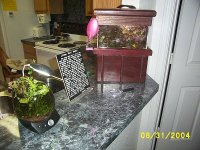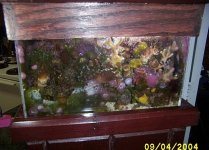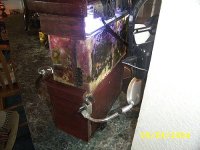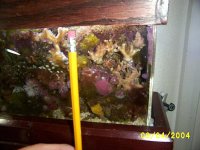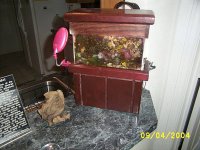Here they are, some updates of the half-gallon reef model. Aquascaping details include layered reef wall to allow for caves in between the plates; even though the scape you see here looks flat it is not--the stenopus boxer often cannot be seen due to hiding among the fissures in between the plates. By plates, I mean the completely encrusted and aged oyster shell I used to attain a flat gluing surface for the coral.
Mounds of tiny LR chips as the base crumbled in time, I found it much easier to densely aquscape the sub-gallon aquarium if I could locate a plate surface that wouldn't shift when bumped.
Note the shot from the side of the tank, this reveals much of the inner workings of the miniature SPS setup. You can see the hidden internal division that houses the baffle refugium, a place of continual internal oxygen and CO2 processing. Note the buildup of coralline to the same scale as a larger reef; monthly chores include credit-card scraping to maintain a see-through window through the growth. I like how it shrouds the viewing area and creates a window as it matures.
This reef runs two weeks in between water changes of 75-100%, weekly topoff and tri-weekly dosings of calcium and alkalinity on alternate days.
Some coral highlights include:
established and balaced system, 11 mos old
Frogspawn, hammer, caulastrea and blastomussa sp. round out the LPS portion of the aquscape. Montipora, acropora x 3 var., pocillopora damicornis comprise the SPS portion of the aquascape and particular care was taken when spacing these warriors often just millimeters apart.
The system is allowed to thrive as nature influences, I don't panic if a small mat of GSP creeps up the side of an SPS stalk. If it becomes rampant, I peel back and trim the GSP and allow the SPS to regrow the area but for the most part life and death is observed in an untouched state in the pico reef as the months go by.
Hitchhiker sponges and clear-bodied tunicates also thrive in the system, I feel Dt's addition helps these organisms feed. The most recent addition is a tiny head of galaxea seen in the right-hand area under the forks of the pocillopora damicornis (soon to be attacked by GSP from above)




